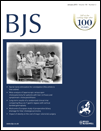Background:
An effective screening tool for colorectal cancer is still lacking. Analysis of the volatile organic compounds (VOCs) linked to cancer is a new frontier in cancer screening, as tumour growth involves several metabolic changes leading to the production of specific compounds that can be detected in exhaled breath. This study investigated whether patients with colorectal cancer have a specific VOC pattern compared with the healthy population.
Methods:
Exhaled breath was collected in an inert bag (Tedlar®) from patients with colorectal cancer and healthy controls (negative at colonoscopy), and processed offline by thermal-desorber gas chromatography–mass spectrometry to evaluate the VOC profile. During the trial phase VOCs of interest were identified and selected, and VOC patterns able to discriminate patients from controls were set up; in the validation phase their discriminant performance was tested on blinded samples. A probabilistic neural network (PNN) validated by the leave-one-out method was used to identify the pattern of VOCs that better discriminated between the two groups.
Results:
Some 37 patients and 41 controls were included in the trial phase. Application of a PNN to a pattern of 15 compounds showed a discriminant performance with a sensitivity of 86 per cent, a specificity of 83 per cent and an accuracy of 85 per cent (area under the receiver operating characteristic (ROC) curve 0·852). The accuracy of PNN analysis was confirmed in the validation phase on a further 25 subjects; the model correctly assigned 19 patients, giving an overall accuracy of 76 per cent.
Conclusion:
The pattern of VOCs in patients with colorectal cancer was different from that in healthy controls. The PNN in this study was able to discriminate patients with colorectal cancer with an accuracy of over 75 per cent. Breath VOC analysis appears to have potential clinical application in colorectal cancer screening, although further studies are required to confirm its reliability in heterogeneous clinical settings. Copyright © 2012 British Journal of Surgery Society Ltd. Published by John Wiley & Sons, Ltd.

